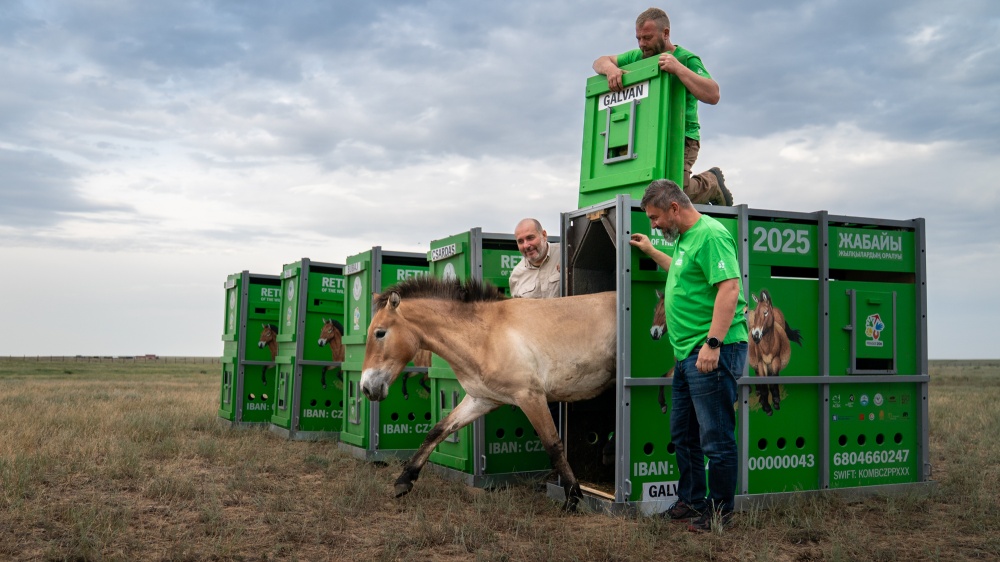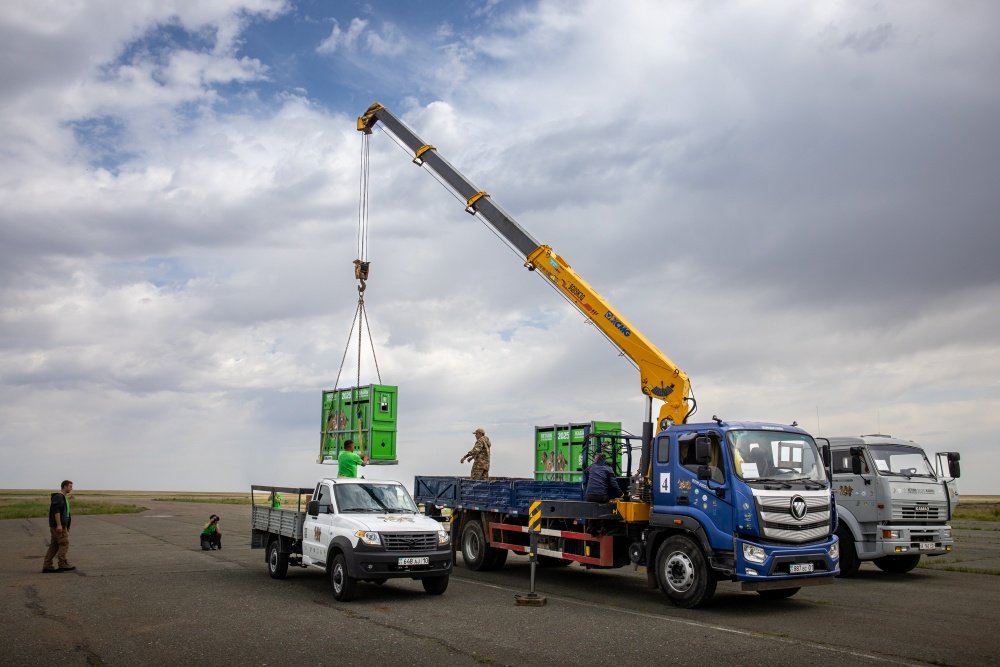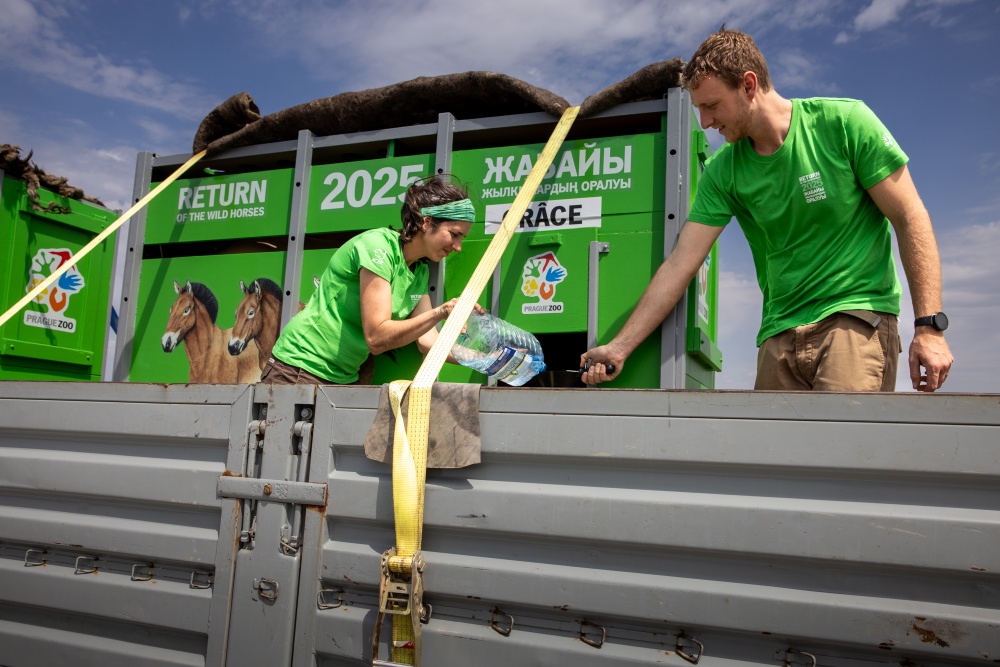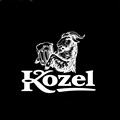Prague zoo transported another seven Przewalski´s horses to Kazakhstan
03. 06. 2025
Today, Prague Zoo, in collaboration with the partners of the Return of the Wild Horses project, released seven Przewalski’s horses into the Golden Steppe in central Kazakhstan. One stallion and six mares were transported from Prague and Debrecen, Hungary, in cooperation with the Czech Army. Stallion Galvan and mares Grâce and Zina II were transferred from the breeding station in Dolní Dobřejov to Prague-Kbely Airport, from where a military CASA aircraft flew them to Arkalyk, Kazakhstan. Mares Csardas, Cili, Bűbaj, and Celeb from Hungary’s Hortobágy National Park were carried by the second Czech aircraft to the same destination. After landing, both transport teams embarked on an eight-hour journey through challenging terrain to the Alibi reintroduction station. Following a transport lasting over 30 hours, all seven horses arrived safely and are now in acclimatization enclosures, having entered them around 7 p.m. local time today. Meanwhile, the horses transported last year, already present in a nearby encolusure, are awaiting their release into the wilderness tomorrow.

Releasing of the stallion Galvan. Photo: Oliver Le Que, Prague Zoo
“The return of wild horses to Central Asia continues. While preparing a brand-new reintroduction effort in eastern Mongolia, we’ve transported another seven Przewalski’s horses to Kazakhstan,” said Miroslav Bobek, Director of Prague Zoo. “Although this year's transport faced perhaps the most complications since our first Przewalski’s horse transfer to western Mongolia in 2011, I consider this success all the more significant. Fourteen horses are now back in the Golden Steppe, where they had disappeared long ago due to human activity. We aim to continue this demanding project in the upcoming years until a viable population of the last wild horse species is established in central Kazakhstan.”
Stallion Galvan was released into a large enclosure alongside the four Hungarian mares. His role as a young stallion is to gradually assume dominance and form a natural harem. Shortly after, mares Zina II and Grâce from Dolní Dobřejov were moved into a neighboring acclimatization enclosure.

Unloading of the horses in Arkalyk. Photo: Miroslav Bobek, Prague Zoo
“The arrival of each Przewalski’s horse is the result of a long-term, well-coordinated work by all partners. We are proud that our vision of rebuilding a wild population of this species in Kazakhstan is steadily becoming a reality. These animals are not only part of our national heritage, but also a vital and important component of a healthy steppe ecosystem,” said Vera Voronova, the director of the Association for the Conservation of Biodiversity of Kazakhstan (ACBK). This nonprofit organization has long been involved in nature conservation, including the Altyn Dala State Nature Reserve – also known as the Golden Steppe – and is a key partner for Prague Zoo.
The newly arrived horses will spend up to a year adapting to local conditions and forming healthy social structures. They will learn to drink from natural ponds and dig for food under the snow cover during winter. Throughout this process, researchers will closely monitor their health, track their development, and assess the effects of extreme weather or seasonal parasites.

Watering and checking the horses on the way to the Alibi reintroduction center. Photo: Miroslav Bobek, Prague Zoo
Organizations involved in the project
Prague Zoo maintains the International Studbook and coordinates the EEP (EAZA Ex Situ Programme) for the Przewalski’s horse. The zoo played a crucial role in the species’ post-WWII rescue and later initiated its reintroduction efforts. It organized nine significant transports of Przewalski’s horses from Europe to western Mongolia. Currently, alongside the Kazakhstan project, it is preparing a new reintroduction project for eastern Mongolia.
The Association for the Conservation of Biodiversity of Kazakhstan (ACBK) is a national public association dedicated to biodiversity preservation and public awareness. The Return of the Wild Horses project is part of its broader initiative to restore original steppe ecosystems. ACBK developed the necessary infrastructure in the Altyn Dala State Nature Reserve, which also hosted earlier kulan reintroductions in cooperation with the Frankfurt Zoological Society.
Hortobágy National Park has previously taken part in Przewalski’s horse reintroductions, including cooperation with Prague Zoo. It is home to the largest Przewalski’s horse population outside the species’ original range. Selected individuals from this population are candidates for future transports to Kazakhstan.
The Committee for Forestry and Wildlife (FWC) operates under the Ministry of Ecology and Natural Resources of the Republic of Kazakhstan. It manages protected areas and initiated the idea to reintroduce Przewalski’s horses in Kazakhstan by reaching to Prague Zoo in the autumn of 2022.
The Frankfurt Zoological Society (FZS) is an international organization active in 18 countries, focused on protecting endangered species and ecosystems. In Kazakhstan, it works on conserving saiga antelopes and kulans. It co-founded the Altyn Dala Conservation Initiative (ADCI) in 2006.
The Czech Air Force, particularly the 24th Air Transportation Base at Prague-Kbely, provides crucial support for transporting the horses. Their cooperation with Prague Zoo dates back to the transport of a gorilla and nine prior Przewalski’s horse transports to western Mongolia between 2011 and 2019.








